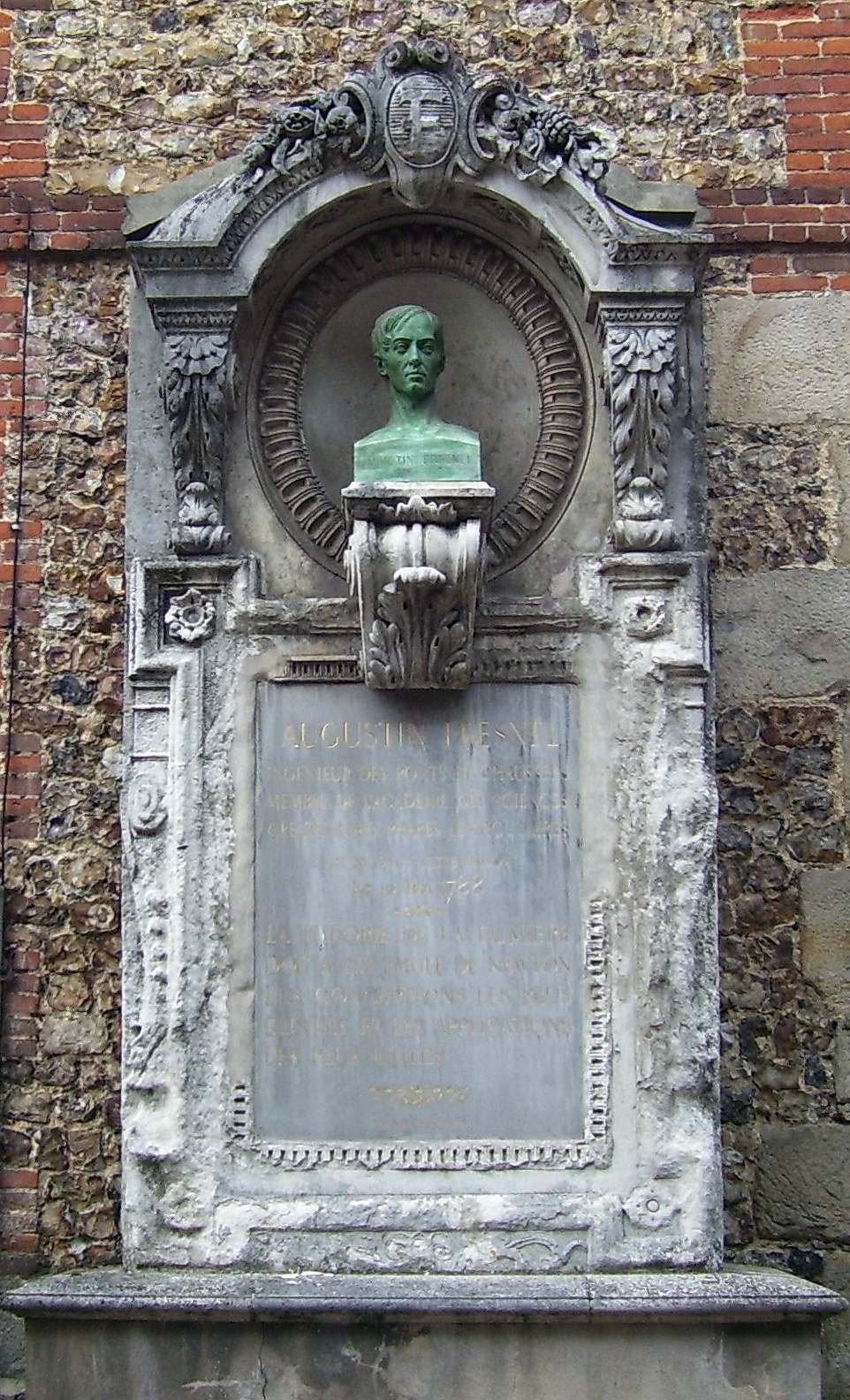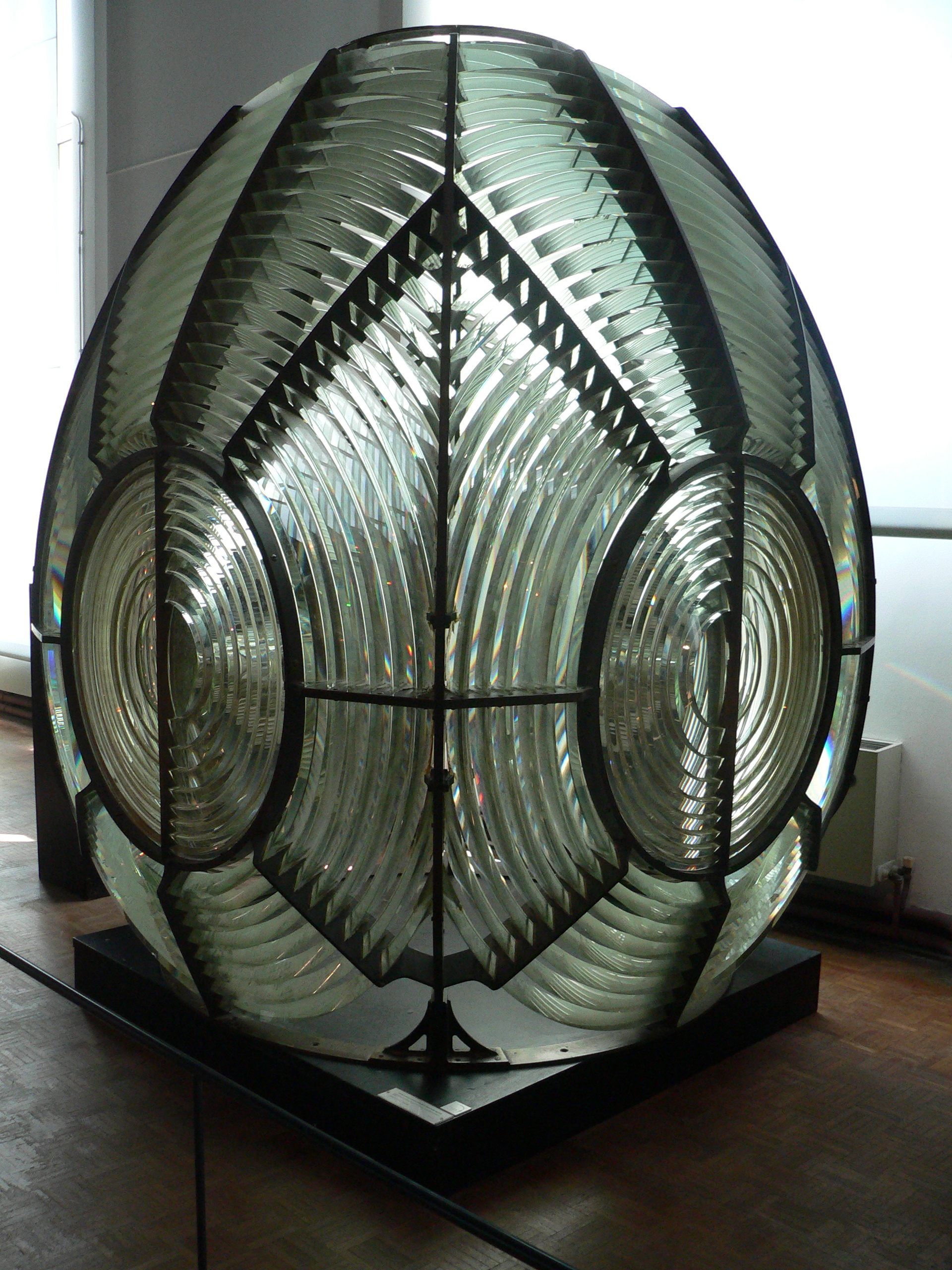|
Fresnel (unit)
A fresnel is a unit of frequency equal to one trillion cycles per second (i.e., 1012 s−1). It was occasionally used in the field of spectroscopy, but its use has been superseded by ''terahertz'' (with the identical value 1012 hertz). It is named for Augustin-Jean Fresnel the physicist whose expertise in optics led to the creation of Fresnel lens A Fresnel lens ( ; ; or ) is a type of composite compact lens (optics), lens which reduces the amount of material required compared to a conventional lens by dividing the lens into a set of concentric annular sections. The simpler Dioptrics, d ...es. Cardarelli, F. 1999. Springer Science & Business Media. References [...More Info...] [...Related Items...] OR: [Wikipedia] [Google] [Baidu] |
Frequency
Frequency is the number of occurrences of a repeating event per unit of time. Frequency is an important parameter used in science and engineering to specify the rate of oscillatory and vibratory phenomena, such as mechanical vibrations, audio signals (sound), radio waves, and light. The interval of time between events is called the period. It is the reciprocal of the frequency. For example, if a heart beats at a frequency of 120 times per minute (2 hertz), its period is one half of a second. Special definitions of frequency are used in certain contexts, such as the angular frequency in rotational or cyclical properties, when the rate of angular progress is measured. Spatial frequency is defined for properties that vary or cccur repeatedly in geometry or space. The unit of measurement of frequency in the International System of Units (SI) is the hertz, having the symbol Hz. Definitions and units For cyclical phenomena such as oscillations, waves, or for examp ... [...More Info...] [...Related Items...] OR: [Wikipedia] [Google] [Baidu] |
Spectroscopy
Spectroscopy is the field of study that measures and interprets electromagnetic spectra. In narrower contexts, spectroscopy is the precise study of color as generalized from visible light to all bands of the electromagnetic spectrum. Spectroscopy, primarily in the electromagnetic spectrum, is a fundamental exploratory tool in the fields of astronomy, chemistry, materials science, and physics, allowing the composition, physical structure and electronic structure of matter to be investigated at the atomic, molecular and macro scale, and over astronomical distances. Historically, spectroscopy originated as the study of the wavelength dependence of the absorption by gas phase matter of visible light dispersed by a prism. Current applications of spectroscopy include biomedical spectroscopy in the areas of tissue analysis and medical imaging. Matter waves and acoustic waves can also be considered forms of radiative energy, and recently gravitational waves have been associa ... [...More Info...] [...Related Items...] OR: [Wikipedia] [Google] [Baidu] |
Hertz
The hertz (symbol: Hz) is the unit of frequency in the International System of Units (SI), often described as being equivalent to one event (or Cycle per second, cycle) per second. The hertz is an SI derived unit whose formal expression in terms of SI base units is 1/s or s−1, meaning that one hertz is one per second or the Inverse second, reciprocal of one second. It is used only in the case of periodic events. It is named after Heinrich Hertz, Heinrich Rudolf Hertz (1857–1894), the first person to provide conclusive proof of the existence of electromagnetic waves. For high frequencies, the unit is commonly expressed in metric prefix, multiples: kilohertz (kHz), megahertz (MHz), gigahertz (GHz), terahertz (THz). Some of the unit's most common uses are in the description of periodic waveforms and musical tones, particularly those used in radio- and audio-related applications. It is also used to describe the clock speeds at which computers and other electronics are driven. T ... [...More Info...] [...Related Items...] OR: [Wikipedia] [Google] [Baidu] |
Augustin-Jean Fresnel
Augustin-Jean Fresnel (10 May 1788 – 14 July 1827) was a French civil engineer and physicist whose research in optics led to the almost unanimous acceptance of the wave theory of light, excluding any remnant of Isaac Newton, Newton's corpuscular theory of light, corpuscular theory, from the late 1830s until the end of the 19th century. He is perhaps better known for inventing the Catadioptric system, catadioptric (reflective/refractive) Fresnel lens and for pioneering the use of "stepped" lenses to extend the visibility of lighthouses, saving countless lives at sea. The simpler Dioptrics, dioptric (purely refractive) stepped lens, first proposed by Georges-Louis Leclerc, Comte de Buffon, Count Buffon and independently reinvented by Fresnel, is used in screen magnifying glass, magnifiers and in condenser lenses for overhead projectors. By expressing Christiaan Huygens, Huygens's principle of secondary waves and Thomas Young (scientist), Young's principle of interference ... [...More Info...] [...Related Items...] OR: [Wikipedia] [Google] [Baidu] |
Optics
Optics is the branch of physics that studies the behaviour and properties of light, including its interactions with matter and the construction of optical instruments, instruments that use or Photodetector, detect it. Optics usually describes the behaviour of visible light, visible, ultraviolet, and infrared light. Light is a type of electromagnetic radiation, and other forms of electromagnetic radiation such as X-rays, microwaves, and radio waves exhibit similar properties. Most optical phenomena can be accounted for by using the Classical electromagnetism, classical electromagnetic description of light, however complete electromagnetic descriptions of light are often difficult to apply in practice. Practical optics is usually done using simplified models. The most common of these, geometric optics, treats light as a collection of Ray (optics), rays that travel in straight lines and bend when they pass through or reflect from surfaces. Physical optics is a more comprehensive mo ... [...More Info...] [...Related Items...] OR: [Wikipedia] [Google] [Baidu] |
Fresnel Lens
A Fresnel lens ( ; ; or ) is a type of composite compact lens (optics), lens which reduces the amount of material required compared to a conventional lens by dividing the lens into a set of concentric annular sections. The simpler Dioptrics, dioptric (purely refraction, refractive) form of the lens was first proposed by Georges-Louis Leclerc, Comte de Buffon, and independently reinvented by the French physicist Augustin-Jean Fresnel (1788–1827) for use in lighthouses. The Catadioptric system, catadioptric (combining refraction and reflection) form of the lens, entirely invented by Fresnel, has outer Prism (optics), prismatic elements that use total internal reflection as well as refraction to capture more oblique light from the light source and add it to the beam, making it visible at greater distances. The design allows the construction of lenses of large aperture and short focal length without the mass and volume of material that would be required by a lens of conventional ... [...More Info...] [...Related Items...] OR: [Wikipedia] [Google] [Baidu] |
Units Of Frequency
Unit may refer to: General measurement * Unit of measurement, a definite magnitude of a physical quantity, defined and adopted by convention or by law **International System of Units (SI), modern form of the metric system **English units, historical units of measurement used in England up to 1824 **Unit of length Science and technology Physical sciences * Natural unit, a physical unit of measurement * Geological unit or rock unit, a volume of identifiable rock or ice * Astronomical unit, a unit of length roughly between the Earth and the Sun Chemistry and medicine * Equivalent (chemistry), a unit of measurement used in chemistry and biology * Unit, a vessel or section of a chemical plant * Blood unit, a measurement in blood transfusion * Enzyme unit, a measurement of active enzyme in a sample * International unit, a unit of measurement for nutrients and drugs Mathematics * Unit number, the number 1 * Unit, identity element * Unit (ring theory), an element that is inver ... [...More Info...] [...Related Items...] OR: [Wikipedia] [Google] [Baidu] |
Obsolete Units Of Measurement
This is a list of obsolete units of measurement, organized by type. These units of measurement are typically no longer used, though some may be in limited use in various regions. For units of measurement that are unusual but not necessarily obsolete, see List of unusual units of measurement. For units of measurement that are humorous in nature, see List of humorous units of measurement. Area * Antsingae – a unit of area, smaller than the bunarium. * Bunarium (plural "bunaria") – a unit of area, equal to about 120 Hectare#Are, ares or 12,000 square metres * Carucate * Cawnie * Decimal (unit), Decimal * Dessiatin * Ground (unit), Ground * Hide (unit), Hide * Juchart * Jugerum * Katha (unit), Katha * Lessa (unit), Lessa or Lecha * Marabba * Morgen * Oxgang * Pari (unit), Pari – a unit of area equal to about 1 hectare * Quinaria * Tathe * Virgate Energy, etc. * Poncelet – unit of power * Sthène – unit of force * * Length * Ald (unit), Ald * Alen (unit of length), Al ... [...More Info...] [...Related Items...] OR: [Wikipedia] [Google] [Baidu] |






